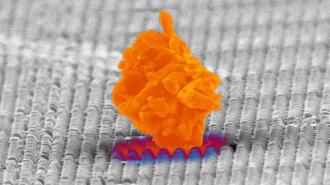A new anti-dust technology that prevents particles from sticking to surfaces could extend the lives of space rovers, improve the efficiency of solar panels, and, yes, perhaps liberate us from household chores.
Dust… in space: Once NASA sends a new rover to the moon or Mars, the goal is to keep it operational as long as possible — the longer the rover is roving, the more valuable data it can send back to Earth.
“There’s not much you can do about lunar dust in space — it sticks to everything.”
Samuel Lee
The surfaces of the moon and Mars are incredibly dusty, though, and over time, this dust will damage a rover’s sensitive instruments and block its solar panels. NASA’s InSight Mars rover died in December 2022 due to the latter problem.
“There’s not much you can do about lunar dust in space — it sticks to everything and there’s no real way to wipe it off or spray it off,” said Samuel Lee, an engineering researcher at the University of Texas at Austin.
What’s new? Backed by a NASA grant, Lee and his collaborators at UT Austin and manufacturing startup Smart Material Solutions have developed a way to prevent dust from sticking to surfaces.
Their process, which combines two fabrication techniques — nanocoining and nanoimprinting — stamps a pattern of tiny pyramids onto what was initially a flat material. Those incredible small protuberances make it hard for dust particles to latch onto the material, so they just slide right off instead.
“What we’ve demonstrated here is a surface that can clean itself.”
Chih-Hao Chang
To demo their anti-dust tech, the researchers covered a smooth surface and one of their engineered surfaces with simulated lunar dust. They then turned the surfaces vertically so that loose dust could fall to the ground.
When they examined the surfaces, they discovered that 35% of the smooth surface was covered with dust compared to just 2% of the engineered surface.
“What we’ve demonstrated here is a surface that can clean itself,” said co-lead author Chih-Hao Chang. “Particulates aren’t able to stick to the surface, so they come off using just the force of gravity.”
Looking ahead: This isn’t the first example of an anti-dust surface, but according to the team, their process is “highly scalable,” which could spur its wider deployment outside the lab.
In addition to helping future NASA rovers overcome space dust, the tech could also be used to create anti-dust solar panels for use here on Earth, which would extend their efficiency without requiring that they be manually cleaned — an increasingly large part of the cost of solar.
Eventually, we might see the fabrication process applied to TV screens, smartphones, and even the windows of our homes, freeing us from the annoying chore of cleaning them — or at least speeding it up.
We’d love to hear from you! If you have a comment about this article or if you have a tip for a future Freethink story, please email us at tips@freethink.com.
